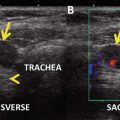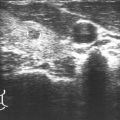Pharmacological
Proton pump inhibitors
Pathological conditions
Neoplastic
Small-cell lung carcinoma
Breast cancer
Neuroendocrine tumors of the lung or gastrointestinal tract
Zollinger’s syndrome
Follicular thyroid tumors
Papillary thyroid microcarcinoma
Nonneoplastic
Chronic renal failure
Autoimmune thyroiditis
Pernicious anemia
Pancreatitis
Hyperparathyroidism
Nonneoplastic hypergastrinemia
Mastocytosis
Type 1A pseudohypoparathyroidism
Sepsis
Heterophilic antibodies
Increased CT levels have been reported in autoimmune thyroiditis, but this association is still controversial [1, 3]. Some studies have also reported decreased CT levels in smaller groups of Hashimoto’s patients, possibly due to atrophy and/or fibrosis associated to destruction of both follicular and C cells [1, 3]. In a recent study [7] investigating the relationship between thyroid autoimmunity and CT levels, basal serum CT was not significantly higher in patients with positive anti-TPO than in control subjects (4.71 ± 6.46 vs. 4.84 ± 13.11 pg/ml; P > 0.05). Importantly, the rate of “suspicious” CT values (above the 10 pg/ml cutoff) did not significantly differ between patients with or without thyroid autoimmunity (3.9 vs. 3.0 %) [7].
Increased CT Levels and Preoperative MTC Diagnosis
The preoperative CT determination displays a much higher diagnostic performance than FNAB for preoperative diagnosis of MTC [1]. In most published studies, basal CT levels >100 pg/ml have a positive predictive value (PPV) for MTC approximating 100 % [1]. For basal CT increases <100 pg/ml, the PPV for MTC diagnosis drops to approximately 10 % [8]. In such instances, performing a stimulation test may improve the specificity of an elevated basal CT level [1].
CT Stimulation Testing for Diagnosis of C-Cell Disease
The most widely used CT stimulation test is performed by a slow intravenous injection of PG (0.5 μg/kg body weight) [1, 9]. Serum CT levels are measured in basal condition and 3 and 5 min after initiation of PG infusion [1, 9]. The test may cause potentially dangerous or unpleasant side effects (i.e., tachycardia, bradycardia, substernal tightness, nausea, vomiting, dizziness, flushing). It is not recommended in subjects over 60 years of age, and it is contraindicated in patients with hypertension and/or those with coronary artery disease [1, 9].
Similar to basal CT, stimulated CT levels are also higher in men than women [1]. A great proportion (80 %) of normal subjects have peak CT levels <10 pg/ml, and the maximal response is <30 pg/ml in 95 % of normals [1]. Stimulated CT levels >100 pg/ml suggest C-cell disease, even though milder elevations may occur in adults with other thyroid abnormalities [1, 9]. In MTC patients, the CT peak after PG stimulation is usually 5–10 times higher than basal levels [1]. Importantly, PG stimulation produces no or more limited increases (zero to twofold rise in CT levels) in other neuroendocrine tumors displaying elevated CT values [10].
A short intravenous calcium infusion may also provoke CT secretion [9]. This approach represents an alternative to PG in areas of the world where PG is not available and may also be combined with PG testing to enhance sensitivity [9]. Serum CT levels measured after a 30 s infusion of calcium gluconate are very similar to those observed after PG administration [9, 11]. In a recent report, the procedure, cutoffs, and the safety of CT testing by calcium gluconate have accurately been defined [11]. The dose of calcium gluconate of 25 mg (i.e., 2.3 mg or 0.12 mEq of elemental calcium)/kg body weight has been shown to be well tolerated and safe. The calculation of the adjusted body weight (www.manuelsweb.com/IBW.htm for ideal body weight and adjusted body weight calculator) has been recommended, to avoid an overdose in obese patients. After a basal CT determination, calcium gluconate should be administered i.v. (5 ml/min) and a 3-min minimum infusion time should be utilized. CT determination should be performed 2, 5, and 10 min after stopping the infusion [11]. In one report, the optimal CT threshold peaks for MTC diagnosis were >79 pg/ml in females and >544 pg/ml in males [11].
CT Determination for MTC Screening
Early diagnosis and radical surgical treatment are considered critical for reducing MTC-related morbidity and mortality [2]. Since virtually all MTC patients have elevated circulating CT levels at the time of diagnosis, several studies performed during the last decade of the past century have suggested that universal screening of patients with thyroid nodular disease by routine measurement of serum CT might improve early diagnosis and improve the long-term prognosis of MTCs [1]. Indeed, a major caveat to the suitability of this approach relates to the discrepancy between the low prevalence of MTC among patients with thyroid nodules (0.26–1.30 %) and the much higher (0.6–6.8 %) frequencies of increased CT levels reported in the majority of published studies [1]. Thus, the PPV of increased basal CT levels resulted rather low (10–40 %), even in those studies in which appropriate selection criteria excluded patients presenting known causes of spurious CT elevations [1]. For this reason, confirmatory testing by CT stimulation was necessary in most studies [1]. Only two reports, by the same group, presented higher (>90 %) PPVs of basal CT measurement [12, 13]. Overall, the stimulated CT levels displayed a greater sensitivity and specificity for MTC diagnosis than basal CT [1]. Nonetheless, the basal cutoff levels used to perform CT stimulation testing varied greatly (5–20 pg/ml) [1]. Similarly, there has been a wide variation among studies concerning the stimulated (either by PG or calcium gluconate) CT values regarded as an indication for surgery (30–1000 pg/ml) [1].
Stay updated, free articles. Join our Telegram channel

Full access? Get Clinical Tree





